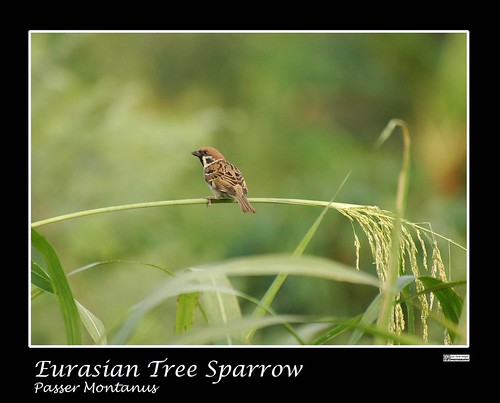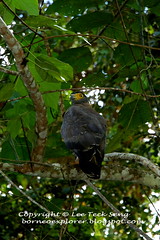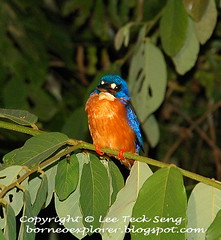
Blogged with Flock

Sexes are visually similar, but young birds have a whitish head, underparts and underwing, the latter showing darker barring.
Blogged with Flock

Blogged with Flock

Saltwater Crocodile Earth’s largest living crocodilian—and, some say, the animal most likely to eat a human—is the saltwater or estuarine crocodile. Average-sized males reach 17 feet (5 meters) and 1,000 pounds (450 kilograms), but specimens 23 feet (7 meters) long and weighing 2,200 pounds (1,000 kilograms) are not uncommon. |

 Storm's Stork (Ciconia stormi)
Storm's Stork (Ciconia stormi)Storks are strong fliers and several species migrate over large distances. They are experts at soaring on thermals and often circle high in the sky, gaining height for easy travel, or searching for likely feeding places.
There are four resident species in the Greater Sundas and three doubtful vagrants.
Description: Large (80 cm) black and white stork with slightly upturned, red bill. Wings, back, crown, and breast black; throat, nape, belly, and tail white. Bare facial skin pinkish red, especially in breeding season. Bare eye-ring is yellow. Distinguished from Woolly-necked Stork by black side of neck, yellow eye-ring, lack of white forehead, and redder bill, but note Javan form of Woolly-necked Stork also has reddish bill and reaches S Sumatra. Immature has black plumage replaced by brown.
Iris-red; bill-red; legs and feet-pink.
Voice: Bill clapping.
Range: Malay Peninsula, Sumatra, and Borneo.
Distribution and status: Sparsely distributed in freshwater swamp and swamp forests in lowlands of Sumatra (including Mentawai) and Borneo. One record from W Java in 1920 (specimen in Bogor museum).
Habits: Frequents dense swamp forests and nests in colonies.

 Asian Glossy Starling
Asian Glossy Starling
R.cantleyi and R.kerrii are found in Peninsular Malaysia whereas R.arnoldii, R. pricei, R. keithii, R. tuan-mudae and R. tengku-adlinii in Sarawak and
· Because of its rarity, knowledge of the biology and ecology of Rafflesia has been slow to accumulate. Even today, little is known about its reproductive biology and distribution, which in itself poses many problems for its conservation.
· As Rafflesia is found in only a handful of localities, its long-term survival is now seriously threatenend by the depletion of the Malaysian rainforest.
· Recent successes from
· Several areas where the Rafflesia spp. are protected includes

The Borneo Elephant or Borneo Pygmy Elephant Elephas maximus borneensis is a subspecies of the Asian Elephant and found in north Borneo (east Sabah and extreme north Kalimantan).
The origin of Borneo elephants was controversial. Two competing hypotheses argued that they are either indigenous, or were introduced, descending from elephants imported in the 16th–18th centuries. In 2003, mitochondrial DNA research has discovered that its ancestors separated from the mainland population during the Pleistocene, about 300,000 years ago. The Borneo elephant became isolated from other Asian elephant populations when land bridges that linked Borneo with the other Sunda Islands and the mainland disappeared after the Last Glacial Maximum, 18,000 years ago.

A dominant male ranges over a large territory mating with several females who give birth to a single offspring, weighting about 4 lbs every three to six years. The gestation period for the orang utan is 233 - 265 days. A mother spends years rearing the infant, and may have only two or three in a lifetime which undoubtedly adds to their diminishing numbers.
The male orang utan grows to around 5ft tall and can weigh up to 200 pounds. Females however only reach half that size. Orang utans reach maturity at 7 - 10 years of age and can live in the wild up to 40 years old.
The orang utan is almost completely arboreal (tree-dwelling), which is why it is found in the lowland forests of Borneo and Sumatra. They have no tails and therefore cannot jump. They navigate round the canopy by climbing and swinging from tree to tree.
They are highly intelligent animals and possess great strength, their strong hands and feet, which can grip like hands, are supremely adapted to life in the trees. Using their long arms, which span between 7-8ft across, they gracefully swing through the forest canopy.
These apes make a fresh nest in the crown of a tree every night and rarely come to the ground to drink – drinking instead the water that collects in tree holes.

The nesting habits of the family are interesting. The incubating females are usually sealed into tree hole nests with mud, leaving only a small aperture through which food can be passed by the male. When the young are hatched the female breaks out but reseals the nest entrance again until the young are ready to leave. Ten species of hornbill occur in Sumatra, eight in Borneo, but only three are found in Java.
Description: Large (100cm) white-tailed hornbill. Both sexes have black back, wings, and belly, but male has creamy head with reddish plume from the nape, and naked yellow gular pouch with a distinct black stripe. Female has black head and neck, and blue gular pouch.Voice: A repeated, short, hoarse, dog-like double yelp koe-guk.
Range: E India, SW China, SE Asia, Malay Peninsula, Borneo, Sumatra, Java, and Bali.
Distribution and status: In Borneo and Sumatra this is a fairly common bird of lowland and hill forest, up to 2000 m. In Java and Bali it is rather local.
Habits: Flies in pairs or small flocks over the forest with heavy wing-beats, seeking fruiting trees. Often mixes at feeding trees with other hornbills.

VANISHING IN THE WILD: MALAYAN SUN BEAR
The smallest bear in the world, an adult male Malayan sun bear is about 4 feet (1.2 m) tall when standing on its hind legs and can weigh up to 140 pounds (64 kg). Despite their small size, sun bears can be very dangerous.
Named for the golden crescent, or "U" shaped golden patch on their chest, sun bears are otherwise all black with smooth, short fur. They are increasingly rare residents of tropical rain forest in southern China, Burma, Malaysia, Sumatra, Laos, Cambodia, Vietnam, and Borneo.
Malayan sun bears are skillful climbers, aided by long sickle-shaped claws on all four feet. These extremely long claws -- up to six inches -- allow the bears to dig for honey and grubs, which they lick up using their long tongues. The bears are omnivores. Their diet also includes fruits, insects, small mammals, and birds. Sun bears sometimes will damage coconut palm, banana, and cocoa plantations through foraging. They usually are nocturnal creatures. Smell is the sun bear's most important sense and their eyesight is not very good.
Many bear species suffer from excessive killing and dramatic habitat loss worldwide. There are eight species of bears in the world: Malayan sun bear, Asiatic black bear, spectacled bear, American black bear, giant panda, sloth bear, polar bear, and brown bear. The northern brown bears have been eliminated from half their former range. Certain Asian bear species are struggling to survive with 75 percent of their former habitat gone. Even the polar bear, seemingly isolated in the Arctic, may be threatened by pollutants in the food chain and proposed oil development in denning areas.
Habitat LossThe majority of the Malayan sun bear's forest habitat has been destroyed by logging and conversion to agriculture. In addition to leveling the forest, logging roads create convenient access for poachers. As natural food sources disappear, sun bears are driven by hunger to forage for food on farms and plantations, where they are shot or trapped by angry farmers.
The demand for bear products is the greatest threat to all bears. Traditional Asian medicine prescribes bear fat, gall, meat, paws, spinal cord, blood, and bones for complaints ranging from baldness to rheumatism. Bear entrees are popular in restaurants, and sun bear paws are favored in Taiwan for soup. The trade in bear gall in particular is so highly profitable that it has been likened to the heroin trade, as dried gall can sell for 18 times the price of gold.
In addition, Malayan people often keep sun bears as pets. The mother bears are killed in order to obtain cubs young enough to tame.
 Pulau Mantanani is a group of three isolated islands northwest of Kota Belud, 80 km north of Kota Kinabalu. It was so isolated in fact that not until recently, only a few locals knew the existence of the islands.
Pulau Mantanani is a group of three isolated islands northwest of Kota Belud, 80 km north of Kota Kinabalu. It was so isolated in fact that not until recently, only a few locals knew the existence of the islands.